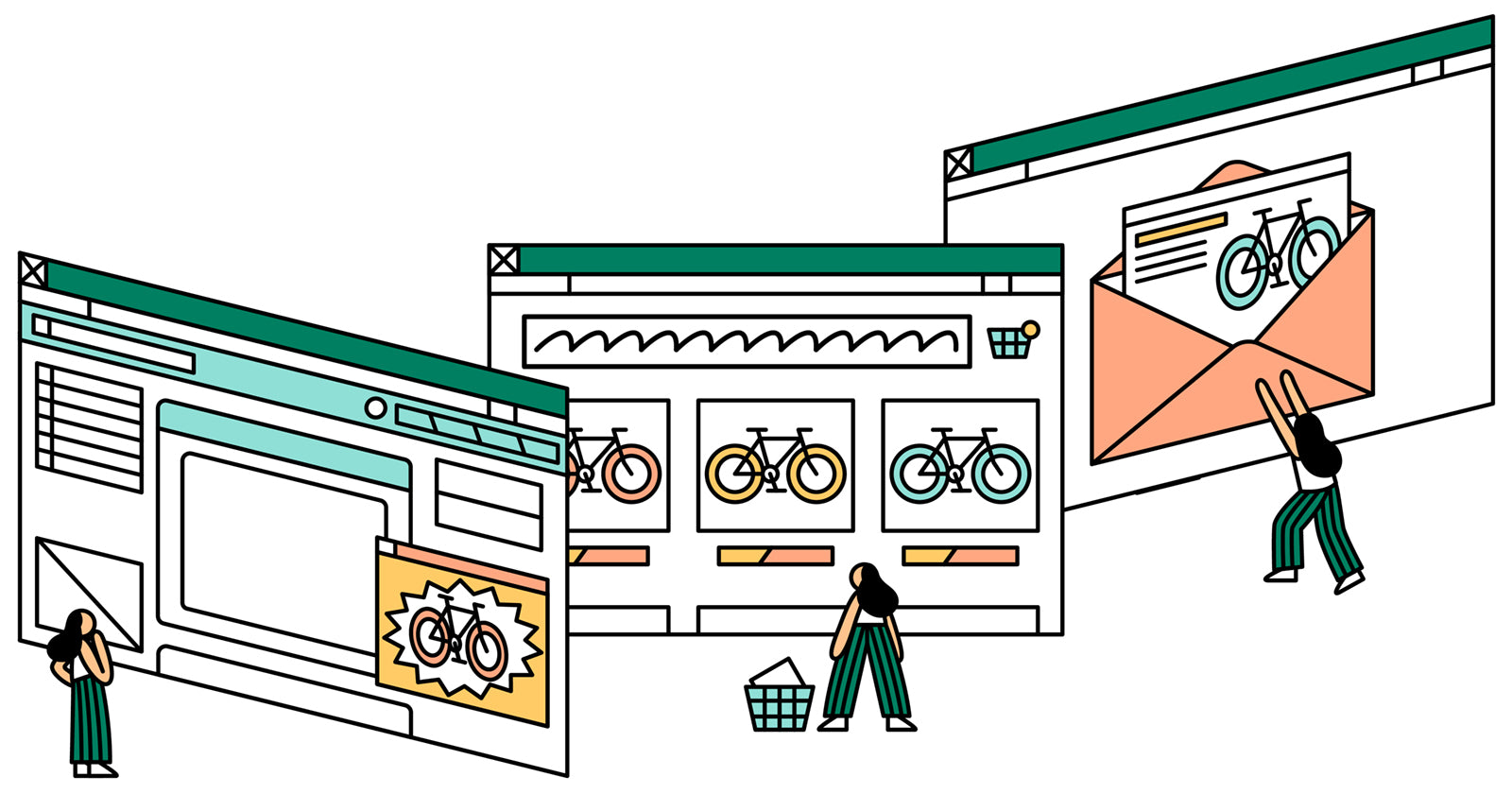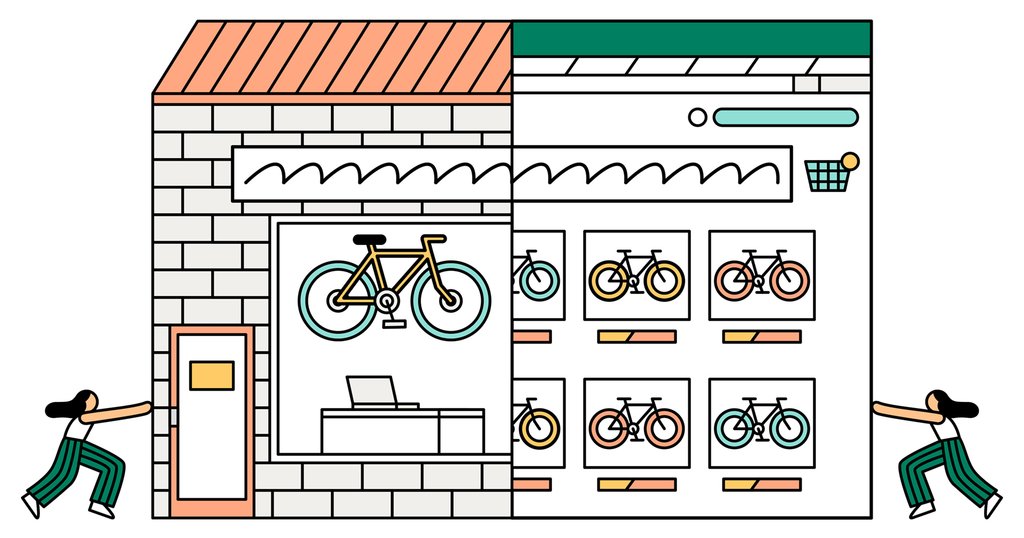Retailer tokyobike had a problem most businesses dream of: people really wanted their products. The catch? They had stores in New York and Tokyo, but their customers were all around the globe.
People would test ride a bike at one of their retail locations and then fly home with a business card, bike specifications, and a credit card authorization form to fill out. Unsurprisingly, many customers found it difficult to follow through with their purchase. An $800 bike isn’t an impulse buy for most people, and the distance between tokyobike’s brick-and-mortar stores and their customers’ locations made the sales loop hard to close.
Clearly, their system wasn’t cutting it.
Fast-forward six months, and their year-over-year sales have increased by 100%. The key to their success? Selling online with a unified commerce platform.
Sell everywhere from one platform
After tokyobike launched their online store using Shopify, they switched their point-of-sale (POS) system to Shopify POS as well. This way, tokyobike is able to offer flexible shopping options for their customers while managing all of their stores using one backend. Their online store and retail spaces are effectively synced.
Now, when shoppers come in for a test-ride and leave without buying, there are no cards or forms to fill out—their shopping cart is automatically emailed and waiting in their inbox when they return home. This allows customers who start their journey in-store to complete it online when they’re ready, reducing the risk of customers losing their card (and tokyobike losing the sale).
As a result, tokyobike’s staff can focus on the in-store experience rather than trying to close sales on the spot.
Where once tokyobike was limited to their storefronts in New York and Tokyo, Shopify’s unified platform allowed them to go global.
The benefits of syncing your storefronts
With a single view of inventory, orders, and customer data, retailers can keep track of what’s happening across their entire business in real time, allowing them to make informed business decisions that drive revenue. Customers reap the benefits of always up-to-date product inventories and the flexibility to browse, pay, and fulfill orders however they want.
Flexible buying journey
On a unified platform, you can offer more purchasing and financing options to your customers at checkout. Shoppers can add a product to their carts online, enter a promo code, and then opt for in-store pickup if they prefer. Or, like tokyobike, you can email customers their carts after an in-store visit so they can complete their purchases from the comfort of their home.
You can even integrate shipping into your POS. Seventy-three percent of customers want order tracking across all touchpoints. With Shopify POS and other unified commerce platforms, you can give customers a tracking number whether they complete an order in-store or online. In short, order management becomes simpler—from purchasing products to order fulfillment to tracking.
More accurate tracking of customer interactions with your brand
In the bygone days of pre-internet shopping, tracking customer behavior was limited to keeping tabs on who came into your store and what they purchased. Today, buyer journeys are more complex, with customers using an increasing number of channels before they complete a purchase. With a consolidated view of your data, you can track customer behavior across every touchpoint, with every touchpoint representing an opportunity to re-engage and nurture.
For example, someone can start their journey by clicking an ad on Facebook. From there, they can create an account with your store, shop around, add an item to their cart, and leave. You can then email them about the item in their cart, including information about your local stores as well. The customer then has the option to purchase via their cart or visit your retail location.

Every one of those interactions is tracked more effectively, so you won’t lose valuable insights into your customers’ behavior as they switch between channels. This information can be used to improve your ad targeting on social media and across sites your audience visits.
You’ll be able to deliver a degree of personalization that will make your customers feel noticed and appreciated by your business. This personalization also extends into how their shopping experience is delivered.
Tailored shopping experiences for customers
Customers expect personalization today. With a single view of purchase history, retailers understand their customers’ preferences and can tailor the shopping experience and their marketing communications.
Using analytics to understand customer behavior across sales channels, you can more accurately predict future shopping behavior, recommending the right product to the right customer at the right time. This also helps for building robust loyalty programs, as you’ll know what appeals most to your customers based on their shopping habits.
Finally, when employees have access to customer profiles and high-level business analytics, you’ll give them better insight into who they’re selling to so they can provide prompt, personal service. It’s no wonder businesses that give their employees access to analytics have seen up to 106% higher sales.
Real time product updates
Giving customers visibility into your products counts for a lot. Ninety-four percent of consumers say they’ll stay loyal to brands that offer complete transparency. One way to be more transparent? Maintain accurate inventory numbers. Doing so offers a number of advantages:
- Reliable stock information. As a customer, it’s frustrating to look in-store for an item you saw online, then find it isn’t there. Unexpected stockouts can hurt your reputation and lose you customers for good. When you have your inventory information shared across every channel, customers (and your staff) have full visibility into whether or not a product is in stock. In fact, 64% of consumers choose a store based on the availability of clear, discernible product information.
- Pricing is always accurate. The moment you have multiple storefronts, you introduce risk of having a pricing disparity between channels or locations. But with your sales channels working in sync, you can easily adjust prices and ensure that they’re accurate and consistent across the board.
- Order and move inventory based on demand. Customers can’t buy what isn’t there. Accurate inventory helps you just as much as it helps your customer, allowing you to see what you need to order more before you run out. With retailers missing out on nearly $1 trillion in sales due to stock issues, having a complete look into inventory availability is essential.
Convenient exchanges and returns
With your online store and retail locations working in tandem, you can ensure your customers have a positive post-purchase experience, too.
A disconnected system leads to messy inventory and accounting, and a painful customer experience.
One major perk that’s easy to implement with Shopify POS and other unified platforms is the flexibility to accept returns in any store location, regardless of where the products were originally purchased. According to Narvar’s 2018 Consumer Returns Report, 89% of repeat customers who have a good return experience are likely to buy again, so offering a convenient return experience can potentially improve your retention rate and increase revenue.
More efficient staff management
Lastly, a unified platform makes it easier to onboard and train new staff. Having to learn numerous systems often means having to memorize several logins, interfaces, and functions. With one platform organizing everything, employees can intuitively learn and use the technology that powers your sales experience. This is especially important for businesses with high employee turnover.
You’ll also reduce the risk of user error, as employees have less data entry to manage on account of the automated inventory updates and customer information tracking.
With many platforms, it’s also possible to assign your employees a PIN or login. This allows you to monitor their sales and offer additional training to anyone who’s struggling.
The future of retail
At its core, a unified commerce approach is about creating harmony between important customer touchpoints by syncing your sales channels and consolidating your backend operations, so that every part of your customer experience feels like a direct extension of your brand.
While multi-channel aims to accomplish the same goal, the use of separate solutions means retailers must rely on costly integrations between systems, and even then, run the risk of creating an experience that feels inconsistent and unreliable.
When you’re able to sell everyone with one platform, the lines between offline and online become blurred—purchases and fulfillment feel fluid to customers, and you and your staff aren’t left wrangling siloed data or dozens of disparate tools to run your business. Not only will customers be grateful for this seamless experience, they’re coming to expect it; one example, today roughly 60% of shopping experiences begin and end on separate devices.
The time to consider one platform for all of your sales channels is now. A unified commerce strategy helped tokyobike pedal their business to new heights, and it can help you, too.
Free Webinar: Introduction to Shopify POS
Get a step-by-step demo of Shopify POS and hear success stories from fast-growing retailers.
Reserve your seat now
